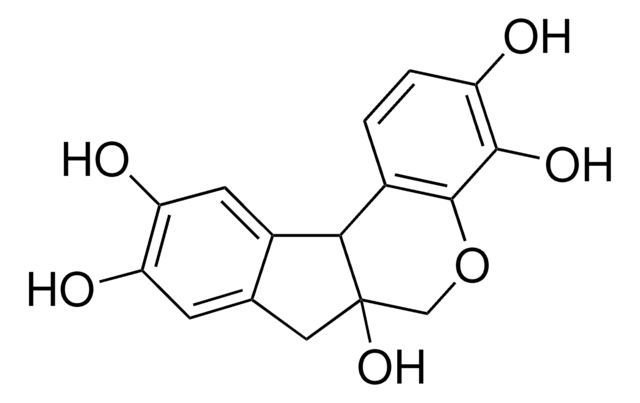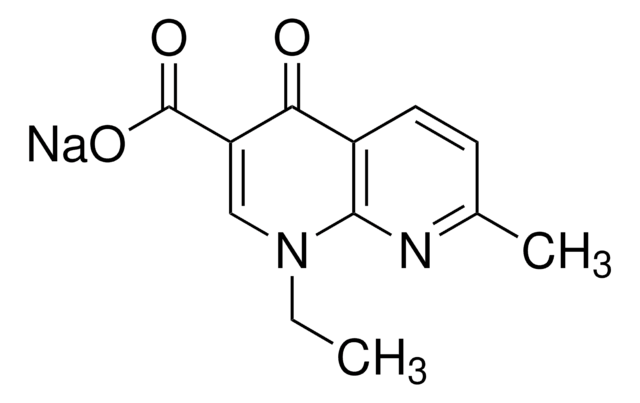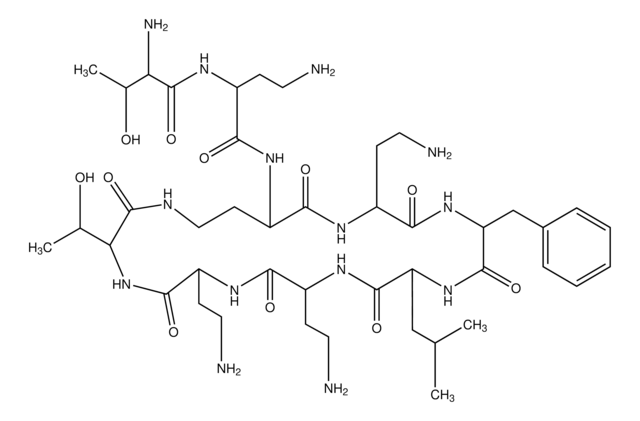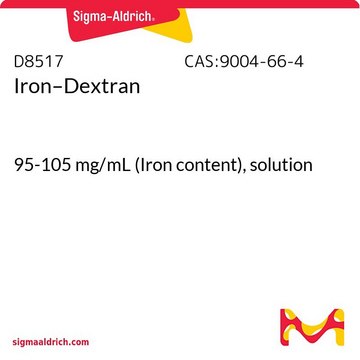5291
Polymyxin B Sulfate
Polymyxin B Sulfate, CAS 1405-20-5, is an antibiotic that is effective against Gram-positive bacteria. Inhibits phospholipid-sensitive Ca2+-dependent protein kinases.
Sinônimo(s):
Polymyxin B Sulfate, Aerosporin
About This Item
Produtos recomendados
Nível de qualidade
forma
solid
fabricante/nome comercial
Calbiochem®
condição de armazenamento
OK to freeze
cor
white to off-white
solubilidade
water: 25 mg/mL
Condições de expedição
ambient
temperatura de armazenamento
10-30°C
InChI
1S/C48H82N16O13.H2O4S/c1-27(2)24-37-47(76)59-32(11-19-52)41(70)56-31(10-18-51)43(72)61-35(14-22-65)39(68)54-21-13-34(45(74)57-33(12-20-53)44(73)64-38(48(77)63-37)25-28-6-4-3-5-7-28)60-42(71)30(9-17-50)58-46(75)36(15-23-66)62-40(69)29(8-16-49)55-26-67;1-5(2,3)4/h3-7,26-27,29-38,65-66H,8-25,49-53H2,1-2H3,(H,54,68)(H,55,67)(H,56,70)(H,57,74)(H,58,75)(H,59,76)(H,60,71)(H,61,72)(H,62,69)(H,63,77)(H,64,73);(H2,1,2,3,4)
chave InChI
HNDFYNOVSOOGDU-UHFFFAOYSA-N
Descrição geral
Aplicação
- to neutralize the endotoxins in bovine serum albumin
- in the in vitro treatment of hepatic stellate cells (HSCs)
- as an antibiotic in collateral sensitivity and cross-resistance analysis in Escherichia coli
Ações bioquímicas/fisiológicas
Advertência
Outras notas
Ngezahayo, A. and Kolb, H.A. 1993. Pflugers Arch.422, 413.
Kubo, M. and Okada, Y. 1992. J. Physiol.456, 351.
Strasser, S.H., et al. 1992. Circ. Res.70, 1304.
Hegemann, L., et al. 1991. Eur. J. Pharmacol.207, 17.
Inaba, H. and Filkins, J.P. 1991. Am. J. Physiol.261, R26.
Marra, M.N., et al. 1990. J. Immunol.144, 662.
Informações legais
Palavra indicadora
Warning
Frases de perigo
Declarações de precaução
Classificações de perigo
Acute Tox. 4 Oral
Código de classe de armazenamento
11 - Combustible Solids
Classe de risco de água (WGK)
WGK 3
Ponto de fulgor (°F)
Not applicable
Ponto de fulgor (°C)
Not applicable
Certificados de análise (COA)
Busque Certificados de análise (COA) digitando o Número do Lote do produto. Os números de lote e remessa podem ser encontrados no rótulo de um produto após a palavra “Lot” ou “Batch”.
Já possui este produto?
Encontre a documentação dos produtos que você adquiriu recentemente na biblioteca de documentos.
Os clientes também visualizaram
Nossa equipe de cientistas tem experiência em todas as áreas de pesquisa, incluindo Life Sciences, ciência de materiais, síntese química, cromatografia, química analítica e muitas outras.
Entre em contato com a assistência técnica








